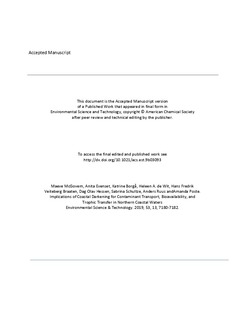| dc.contributor.author | McGovern, Maeve | |
| dc.contributor.author | Evenset, Anita | |
| dc.contributor.author | Borgå, Katrine | |
| dc.contributor.author | Wit, Heleen de | |
| dc.contributor.author | Braaten, Hans Fredrik Veiteberg | |
| dc.contributor.author | Hessen, Dag Olav | |
| dc.contributor.author | Schultze, Sabrina | |
| dc.contributor.author | Ruus, Anders | |
| dc.contributor.author | Poste, Amanda | |
| dc.date.accessioned | 2019-11-21T10:01:44Z | |
| dc.date.available | 2019-11-21T10:01:44Z | |
| dc.date.created | 2019-10-18T10:12:10Z | |
| dc.date.issued | 2019 | |
| dc.identifier.citation | Environmental Science and Technology. 2019, 53 (13), 7180-7182. | nb_NO |
| dc.identifier.issn | 0013-936X | |
| dc.identifier.uri | http://hdl.handle.net/11250/2629687 | |
| dc.description | Embargo until 13 June 2020 | nb_NO |
| dc.description.abstract | The increased transport of terrestrially derived organic material (tOM) from catchments to rivers and lakes is leading to browning of northern freshwaters.(1) Although the same environmental drivers can be expected to lead to widespread increases in tOM and subsequent darkening in adjacent coastal systems,(2) this has received considerably less attention, and long-term monitoring data for detecting these changes are scarce. This is despite expectations that darkening is likely to have a range of implications for coastal biogeochemistry and food-web ecology. tOM is accompanied by other catchment-derived materials including contaminants, inorganic particles, and nutrients. Together, these terrestrial inputs can affect cycling and food-web accumulation of contaminants, in particular, methyl mercury (MeHg) and persistent organic pollutants (POPs). Because of the human and ecosystem health risks associated with these contaminants, and to ensure informed policy decisions, there is a need for a better understanding of the drivers of darkening and their direct and indirect impacts on the transport, bioavailability, and trophic transfer of contaminants in northern coastal waters. | nb_NO |
| dc.language.iso | eng | nb_NO |
| dc.publisher | American Chemical Society | nb_NO |
| dc.title | Implications of Coastal Darkening for Contaminant Transport, Bioavailability, and Trophic Transfer in Northern Coastal Waters | nb_NO |
| dc.type | Journal article | nb_NO |
| dc.type | Peer reviewed | nb_NO |
| dc.description.version | acceptedVersion | nb_NO |
| dc.source.pagenumber | 7180-7182 | nb_NO |
| dc.source.volume | 53 | nb_NO |
| dc.source.journal | Environmental Science and Technology | nb_NO |
| dc.source.issue | 13 | nb_NO |
| dc.identifier.doi | 10.1021/acs.est.9b03093 | |
| dc.identifier.cristin | 1738267 | |
| dc.relation.project | Norges forskningsråd: 243644 | nb_NO |
| dc.relation.project | Norges forskningsråd: 268458 | nb_NO |
| cristin.unitcode | 7464,30,23,0 | |
| cristin.unitcode | 7464,20,19,0 | |
| cristin.unitname | Nedbørfeltprosesser | |
| cristin.unitname | Miljøgifter | |
| cristin.ispublished | true | |
| cristin.fulltext | postprint | |
| cristin.qualitycode | 2 | |
